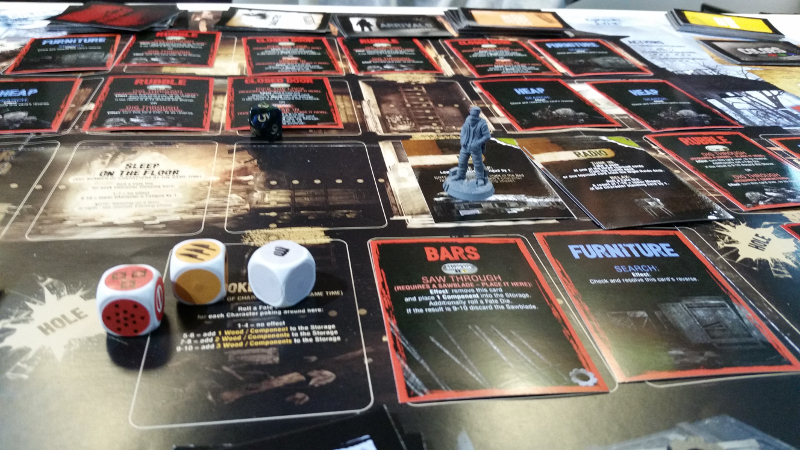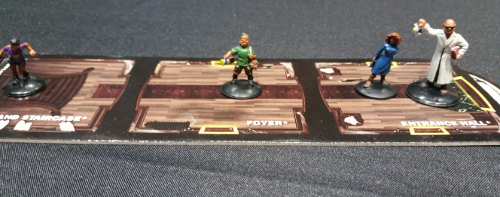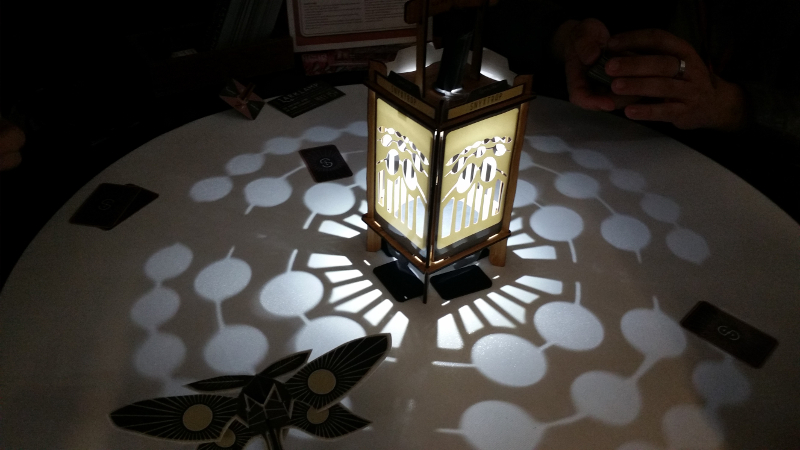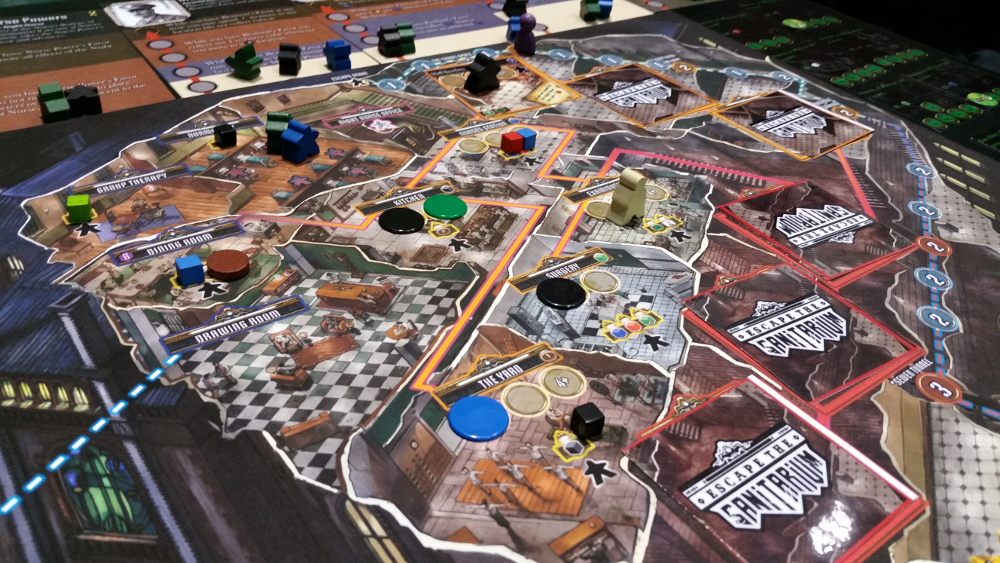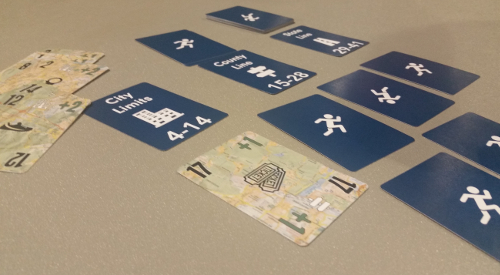What follows are my favorite things about PAX East 2016, in no particular order.
This War Of Mine – The Board Game
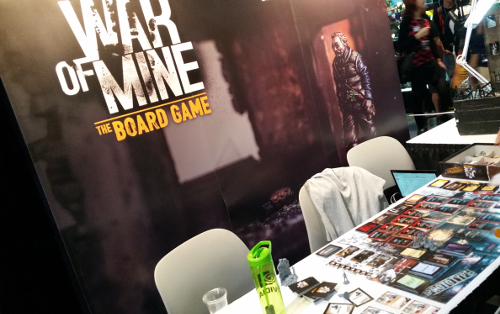 Mere days before the doors to PAX East were cast open, a Twitter conversation enlightened me to the existence of a planned board game adaptation of This War Of Mine, a gritty, brutal, and highly successful video game that came out in 2014. Every year I drift further and further from the pulse of the video game world, so the entire game concept was foreign to me, as was the slowly burgeoning hype for the board game it was based on.
Mere days before the doors to PAX East were cast open, a Twitter conversation enlightened me to the existence of a planned board game adaptation of This War Of Mine, a gritty, brutal, and highly successful video game that came out in 2014. Every year I drift further and further from the pulse of the video game world, so the entire game concept was foreign to me, as was the slowly burgeoning hype for the board game it was based on.
For those like me and are simply clueless to such things nowadays, This War of Mine is a unique video game on two levels. First, the game focuses on the civilians of a war-torn scenario more than the soldiers actually fighting in it. In this game, you’re not running around guns blazing. You’re no soldier – you’re just an average person trying to survive through the day by hiding inside and can only venture out to gather necessities to stay alive under the cover of night. Second…it’s based on real world events. This War of Mine mimics the four year Bosnian crisis in Sarajevo during the mid 1990’s, but it could in reality be any number of existing conflicts around the world. This War Of Mine doesn’t glorify war. It underscores the unseen and untold casualties of it, from privation to starvation, from civilian casualties to a breakdown of civil society altogether.
By sheer coincidence, I turned a corner on the video game floor Friday morning and ran smack into a booth that was showing off the board game prototype in question. The board game version is being designed by none other than Michal Oracz, most known for his work with Portal titles Theseus, Neuroshima Hex, and the also-upcoming Cry Havoc. Intrigued, I ended up sticking around and getting a detailed walkthrough of how the game is going to function. Adapting any IP into another medium is tricky, so even though I was only marginally aware of the source game, I wanted to see how faithful this pending board game was going to be.
And based on what I’ve seen, Michal has done exactly that. While you can adjust the scale of difficulty to the game each playthrough, This War Of Mine seems every bit as brutal – and sobering – as its video game counterpart. In this cooperative game all you need to do is survive through a set number of rounds. It sounds simple, but there’s a lot going against you. In this one, your day actions are spent sleeping, assembling items in your hideout, and generally doing whatever needs to be done to stay alive. By night, you must risk venturing out to locations to scavenge for tools, food, and parts to give your group a fighting chance.
All of this is done against the backdrop of storyline-driven event prompts. Events can cause you to lose your stored food, or run into unsavory people looking for a fight, or find a cache of machinery. Your characters can even arbitrarily be killed off. There are no guarantees here. It’s dark, difficult, and surviving till the ceasefire is easier said than done.
This War Of Mine (which launches on Kickstarter next month) has a definitive Dead of Winter / Robinson Crusoe level of unforgiving punishment paired with Arabian Nights style storytelling. Neither form of the game shies away from highlighting the tragedy of real life conflict, using it to highlight that such things happen all the time, but it does that while still offering a substantive and engaging game about enduring. War is hell, and this game has you live through it.
Lazer Ryderz
Of all the unpublished games found at PAX this year, the one that seemed to constantly catch people’s attending, including ours, was a simple little game at the Unpub booth called Lazer Ryderz. I regrettably didn’t get to play many of the games at the Unpub table this time around, although the volume of titles seemed down compared to last year, so may have been a factor. I only really sat down to look at two. The first was Vel Winter by Ironmark Games, a resource management and action taking game about planetary conquest which I’ll be watching for down the road. The other was Lazer Ryderz. This game, designed by the good folks of Cardboard Fortress, is one of those games that exudes elegance in simplicity.
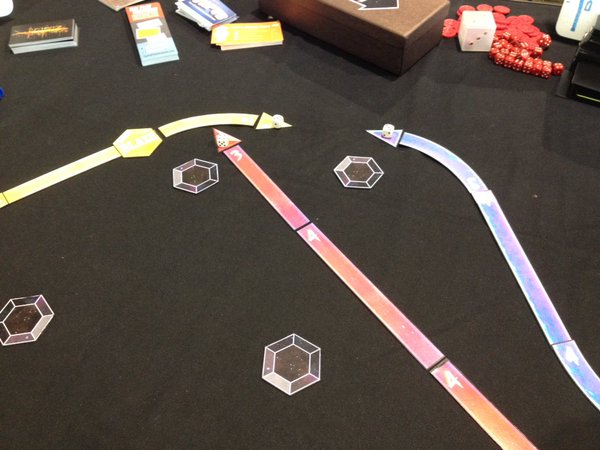 Lazer Ryderz is basically the light cycle race from Tron without the name. In this brief racing game, players command a light ship whose mission is to pass through three randomly placed checkpoints. On your turn, you either move from your current position or come in from the side of the table if you crashed.
Lazer Ryderz is basically the light cycle race from Tron without the name. In this brief racing game, players command a light ship whose mission is to pass through three randomly placed checkpoints. On your turn, you either move from your current position or come in from the side of the table if you crashed.
Your ship has a speed value of 1-5 that you can adjust up or down by one each turn. The speed corresponds to a track that you place down on the board, with higher speed tracks having longer pieces. Straight pieces have no extra requirement, but if you want to place a curved track piece you must roll a die result equal to or higher than your speed or continue moving straight.
That’s…pretty much it. If you can get your path to go through a checkpoint, you claim it and a new random checkpoint is created – though another player can pass through and steal them. However, in typical light-racing fashion, if your ship ends up touching the path of anyone else, your ship crashes and you have to start the ship path over again. The first person to get three checkpoints wins.
I’m not even 100% sure why this game is so entertaining to play, but it has a certain quality to it that was just pure fun. Maybe it was watching the ship tracks unfold on the board or that the game is highly intuitive. All I know is that Lazer Ryderz was on display for practically all of PAX and there was almost always a group at the table. I’m eager to see what the future holds for this one, and based on the reception this game got, I can guarantee you’ll hear more about this game in the future.
Widow’s Walk
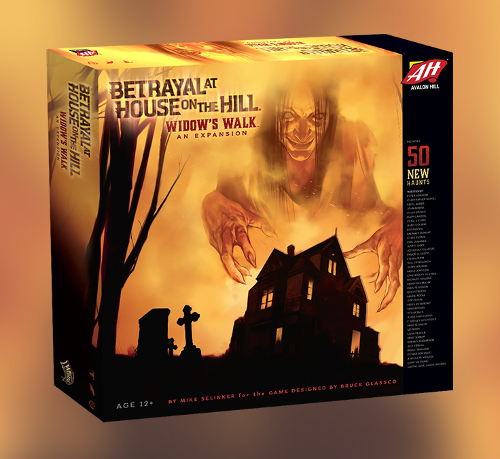 Just before PAX began, Wizards of the Coast released a news tidbit that spread like wildfire throughout the gaming community. They announced that they would be releasing an expansion – finally – to the much beloved Betrayal at House On the Hill. The game originally came out in 2004 with a 2nd edition in 2010, and yet interest in this haunted house themed game has never really abated.
Just before PAX began, Wizards of the Coast released a news tidbit that spread like wildfire throughout the gaming community. They announced that they would be releasing an expansion – finally – to the much beloved Betrayal at House On the Hill. The game originally came out in 2004 with a 2nd edition in 2010, and yet interest in this haunted house themed game has never really abated.
Of course, I completely underestimated just how widespread peoples’ appreciation of the game was, because the speed at which the news permeated across the hobby took me by surprise. But that’s another story.
Anyhow, we were lucky enough to get a demo of the expansion, Widow’s Walk, which is due out later this year. Our expedition actually lasted for quite some time before succumbing to the lure of the Rose Red-style murder house. I won’t spoil exactly what happened, but I will say it involved a clown. And that’s pretty scary by itself.
Most of the information about Widow’s Walk was public by the time we sat down to try it. Widow’s Walk will be a small expansion, adding a couple dozen new tiles and introducing a new floor (the Roof). It also comes with 30 new Item, Omen, and Event cards that add new wrinkles to the draws. The biggest addition is 50 new stories, many written by recognizable names within gaming and geek culture in general, which effectively doubles the possible stories Betrayal has to offer.
We did learn a few additional things during our demo however, including:
- The anticipated MSRP will be around $25
- The expansion is not coinciding with any changes to the base game, nor is there a new edition planned
- All of the stories in the book credit who wrote which one
- Aside from the new Roof tiles, the only other notable new in-game mechanic are tiles with a “dumbwaiter’ symbol. Dumbwaiter tiles make it easier to move around the house by letting you move between them as if they were adjacent (albeit with added cost).
- Widow’s Walk adds a bathroom tile, which is curiously absent from the base game. Really. Go check. Weird, right?
While Widow’s Walk doesn’t really change the gameplay to Betrayal much beyond adding more variety to components, it still seems like it’ll be a good addition to the base game. We’re looking forward to going crazy with all new stories.
The Tabletop Section
One of the most frustrating thing about any game convention, regardless of size, is the accommodation of both the exhibitors showing off games as well as table space for people to play them. Some conventions do a better job than others at providing adequate space for both. Usually, the larger a convention gets, the harder it is to find play space. For the last few years that’s certainly been the case with PAX East, with 2015 being particularly awful. The tabletop area of last year’s PAX was consistently crowded, overly noisy, and it took longer to check a title out of the game library than it did to play some of them.
That also says nothing of the insane level of off-limits tables throughout the day reserved strictly for Magic: the Gathering and other card-based tournaments.
This year was quite refreshing, comparatively speaking. There were definitely crowds to contend with at peak times and one can’t do much about the cavernous noise of the BCEC, but checkout times for games were substantially lower and the amount of reserved tables was cut by more than half. In fact, thanks to better organization, the free play area was 55% larger than last year – which is commendable. The result is that the tabletop area felt distinctly less congested than in the past. Now, I’d like to say that is solely because of these changes, though I also have an unsubstantiated inclination that overall foot traffic in the tabletop area was down somewhat. Nevertheless, it felt like a step in the right direction.
The Indie Megabooth (Again)
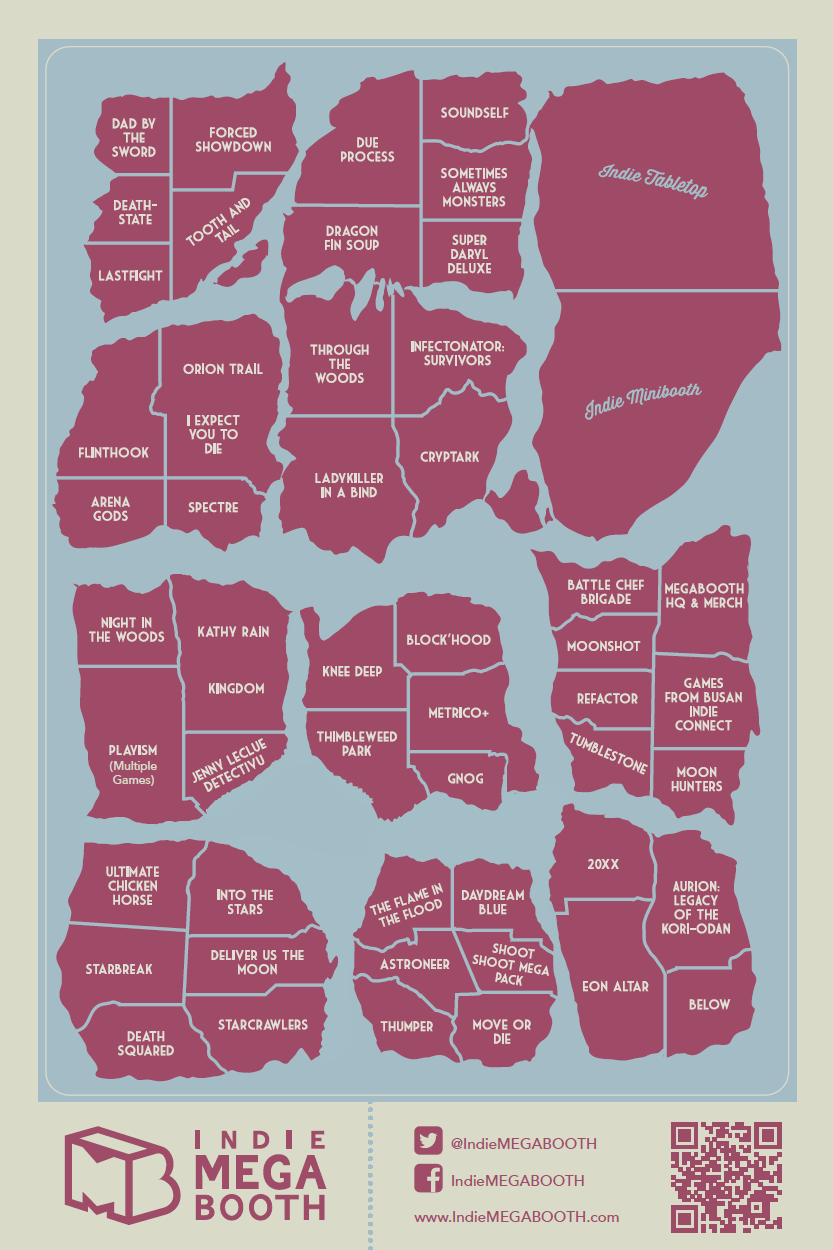 Year over year you see a small but incremental increase of tabletop games represented on the expo floor. Usually they tend to be found on the periphery rather than in the middle. That was even more true this year, as the vast majority of any tabletop representation was found in a single quadrant of the show floor.
Year over year you see a small but incremental increase of tabletop games represented on the expo floor. Usually they tend to be found on the periphery rather than in the middle. That was even more true this year, as the vast majority of any tabletop representation was found in a single quadrant of the show floor.
This included perennial expo exhibitors like Game Salute as well as new faces like Action Phase Games and Formal Ferret Games, to name a few. A handful of exceptions to this were found scattered about elsewhere, such as Mayfair Games, White Wizard Games, and the aforementioned This War Of Mine demos, but most were found in the same stretch of geek-laden highway.
Generally, I enjoy the theory of tabletop being found on the expo floor since it gives additional exposure to the hobby, and the number of tabletop booths were about the same as last year. I also enjoyed them being somewhat clustered and easy to find this year, though anecdotal observations seemed to be that it came as a tradeoff since this clustering didn’t necessarily translate into an increase in foot traffic or sales. Rather, it seemed that while the tabletop fans liked it, in some ways it almost made it easier for wide-eyed wanderers to skip. Still, I think it’s the better choice of a floor plan than having them scattered haphazardly.
In contrast to most booth placements, however, was the returning Indie Megabooth. Sponsored in part by the people behind Cards Against Humanity, the Indie Megabooth once again claimed prime real estate in the middle of the show floor. It’s been a staple locale for several years now, giving ideal space to indie video game and tabletop folks looking to show their wares on floor space they otherwise wouldn’t likely be able to afford. Some of the studios and games chosen are so indie that there’s a good chance they wouldn’t have been able to appear at PAX at all otherwise. Hence why people chosen for the Megabooth are often elated for the opportunity, and I can’t fault that.
The Megabooth this year hosted 88 games, 9 higher than in 2015. Yet this is bittersweet on two fronts. First, the number of tabletop games showcased actually dropped from 11 to 10. Second, the actual square footage for the Megabooth wasn’t that different from last year, which means things got slightly more crowded. Some of that space was taken from the tabletop portion, which made things a bit more cramped for the games being shown.
I was undeterred. I always enjoy checking out what games made the final cut, and I checked several of them out. In addition to currently published games Gruff by Studio Woe (about mutant goats) and the tableau-building game Monarch (now under the newly-named company Resonym), I got to see several upcoming titles. These included:
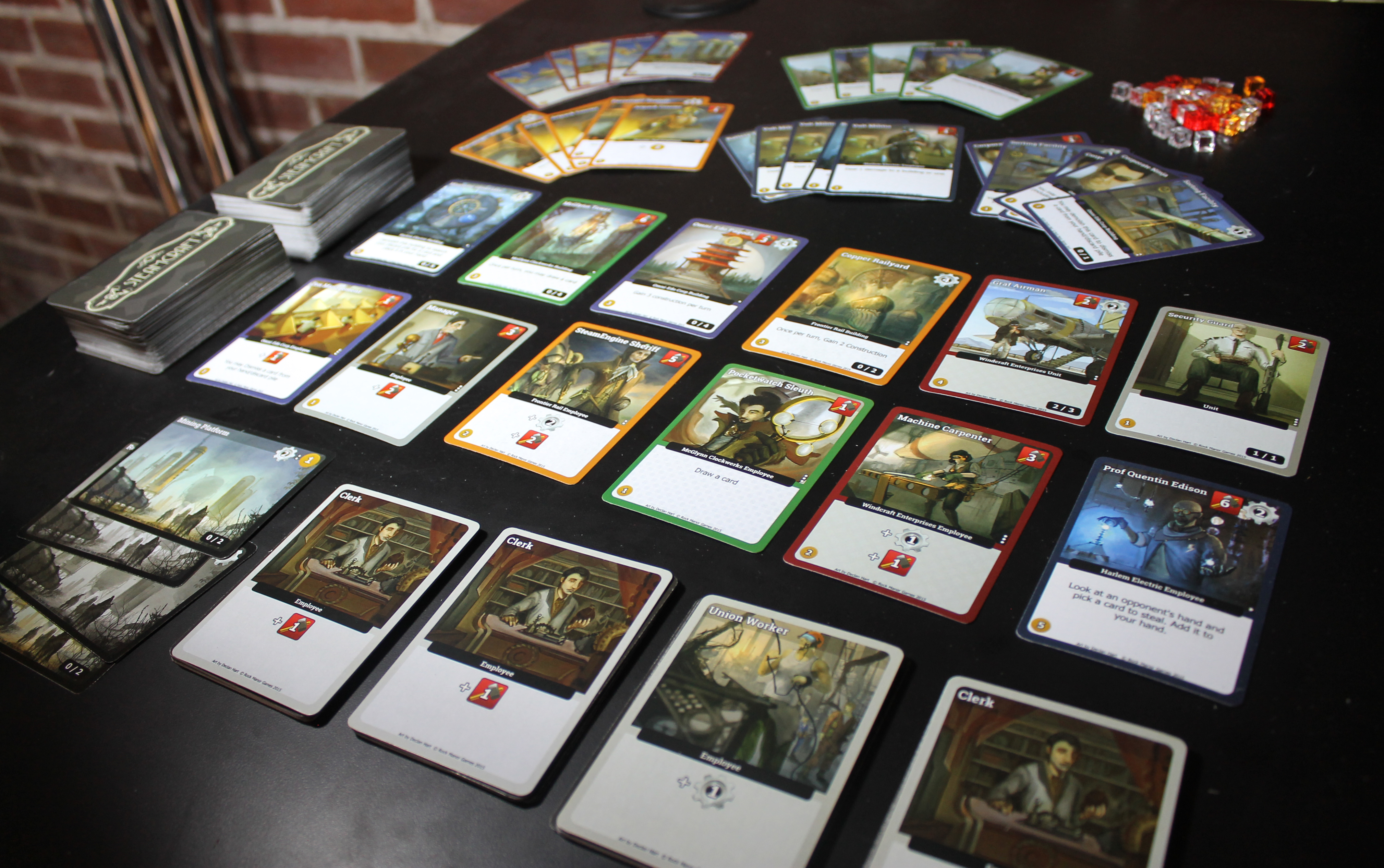 Brass Empire by Rock Manor Games: At its most basic, Brass Empire is a steampunk deckbuilding game, which, admittedly, caught my attention – I’m a sucker for both. In this one, players recruit employees to raise their labor and construct buildings to increase their economic wealth. The goal, naturally, is to create a business empire that beats those of any of your rivals.
Brass Empire by Rock Manor Games: At its most basic, Brass Empire is a steampunk deckbuilding game, which, admittedly, caught my attention – I’m a sucker for both. In this one, players recruit employees to raise their labor and construct buildings to increase their economic wealth. The goal, naturally, is to create a business empire that beats those of any of your rivals.
The catch is, like the real business world, you don’t do this in isolation. So you are actively competing to undermine your opposition by investing in cards that directly attack the infrastructure of other players. Doing so isn’t just an option, it’s a requirement to keep them in check. I’m a little cautious of aggressive-style deckbuilders after burning out on Star Realms, but I left the table curious to give it a try. Brass Empire has a very similar aesthetic and feel to Ascension but with added conflict between players. Not Star Realms level conflict, but this isn’t Dominion either since your assets aren’t guaranteed to stay safe. The game successfully funded on Kickstarter in Nov. 2015 and is due out later this year.
- Breaker Blocks by Spriteborne: Breaker Blocks is the quintessential indie game: it’s a self-made, print-on-demand operation. No Kickstarter, no major publisher. Just one guy showing off a simple little abstract game. It’s hard to do that in the Kickstarter era and still get attention, so I have to salute Spriteborne for making it to the Megabooth all the same. Breaker Blocks is a pretty simple 10 minute game wherein you have a center block with 3 ‘circuits’ on it. Your goal is to draft tiles of different values and abilities and then place them connecting to existing tiles such that you gain control over two or more circuits. It’s pretty straightforward and definitely gave off the same vibe to me as last year’s Megabooth title (and later Indie Spotlight game) Resistor_. Still, if you like simple but engaging abstract games, feel free to give this one a look.
 The Depths of Durangrar by Creative Cove Games: I’m all for innovation in the gaming industry, and this one certainly qualifies. I remember thinking the same thing when I saw this game at the Boston Festival of Indie Games in 2015, and again when it launched its current Kickstarter. In this game, you are a group of adventurers on a dungeon crawling adventure trying to find treasure. Except, you’re intended to play it in the dark.
The Depths of Durangrar by Creative Cove Games: I’m all for innovation in the gaming industry, and this one certainly qualifies. I remember thinking the same thing when I saw this game at the Boston Festival of Indie Games in 2015, and again when it launched its current Kickstarter. In this game, you are a group of adventurers on a dungeon crawling adventure trying to find treasure. Except, you’re intended to play it in the dark.
Therein lies the hook: player pieces glow in the dark to illuminate things around them, while one player uses night vision goggles to act as the labyrinth’s monster hunting them down. I didn’t get a chance to play it again, but it seemed the same since last inspection. I give full marks for creativity, though I do wonder about its viability on a larger scale. I’d love to be proven wrong on this one, but I’m skeptical it can reach a wide audience due to the light and night vision requirements. (Never thought I’d say that about a board game.)
- Dragoon by Lay Waste Games: There be dragons here! Yes, Dragoon is about dragons. Dragons made of metal. Dragons made of metal that don’t want to share their hoard with others. In this one, you are competing with the other dragons to be the first to fill your cave up with gold, either by razing villages or extorting tribute – or both. This is done through a combination of actions and a hand of cards. The whole thing is pretty concise, really. What makes Dragoon stand out though is its components, juxtaposing a cloth player board alongside angular metal pieces. It’s a visually striking game with a fair amount of engagement to it, and it’s just a good bit of gold-snatching fun. Its heft comes from physical weight more than anything else. At any rate, the game successfully delivered their Kickstarter just prior to PAX and was actually selling copies in the tabletop area.
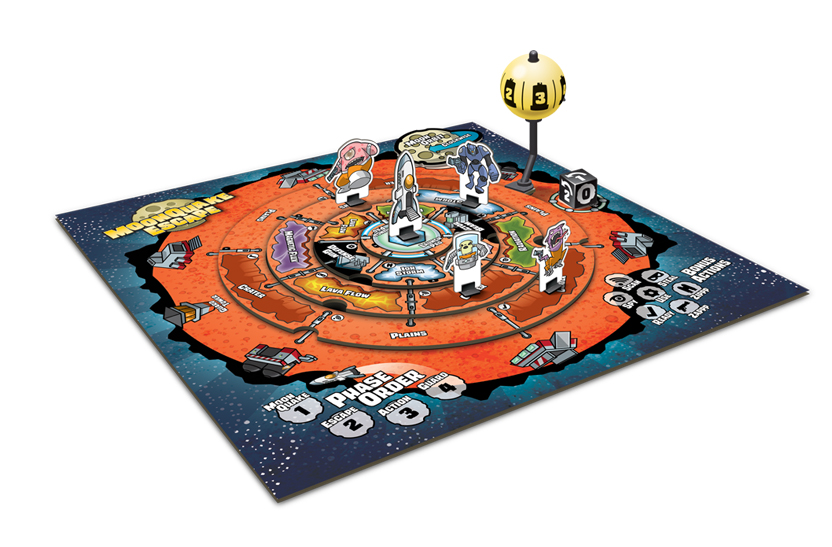 Moonquake Escape by Jair of Jacks Games / Breaking Games: “Moonquake!” as creator Jeff Johnston likes to exclaim at the start of every demo, has become a common refrain of his at regional conventions around here. This lightweight take-that style game is about prisoners of a moon prison competing to escape in the only rocket off your current hunk of rock before the whole thing blows up.
Moonquake Escape by Jair of Jacks Games / Breaking Games: “Moonquake!” as creator Jeff Johnston likes to exclaim at the start of every demo, has become a common refrain of his at regional conventions around here. This lightweight take-that style game is about prisoners of a moon prison competing to escape in the only rocket off your current hunk of rock before the whole thing blows up.
Players must move around the board, avoiding hazards, guards, and one another, all while contending with the shifting board itself. It’s been in development for a couple years now and has taken time getting the art and components correct due to the game using a three-tier movable board track and a spinning moon. We saw the very early prototype a few years back and it’s certainly come a long way since then. It’s a fairly light game of conflict and strife, but it’s finally close to seeing the light of day. Expect to see more Moonquakes your way towards the end of this year.
As a side note, on a video game level I was irrationally excited to see that Thimbleweed Park was on display in the Megabooth as well. Thimbleweed Park is a game written and designed by the same two minds behind the original two Monkey Island games, which were some of my favorite computer games when I was younger. It’s a detective noir story that looks and behaves almost exactly the same as those 90’s era classics, and I’m on board with this, like, 1000%. Even if it is completely devoid of Threepwoods.
Lanterns and Evolution Ports
Digital ports of existing board games is becoming an increasingly common occurrence. For some, it’s the idea of convenience, where you get to play a game you enjoy on a phone or tablet when getting the real thing to the table isn’t an option. For others, it’s just simpler not worrying about things like point salad-style scoring, excessive downtime, or combative opponents. For others still, it’s a cost issue, with digital versions of the game usually being substantially cheaper than their physical counterpart. There are numerous angles that factor into their rise in popularity, but the fact is that they are certainly on an upswing with both gamers and developers.
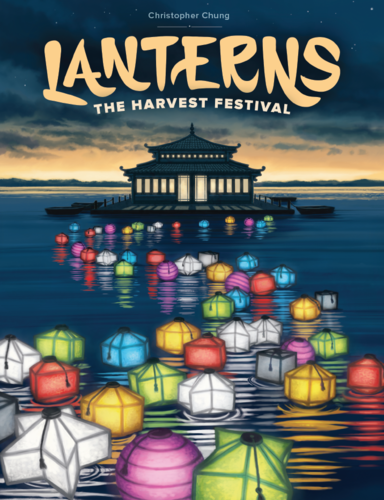 Given that PAX is all about the digital realm, it’s only fitting that there be at least one such digital port being shown off. Past years saw adaptations of Sentinels of the Multiverse and Star Realms being demoed. This year, there were two such digital ports on display: the casual tile-laying game Lanterns by Foxtrot Games & Renegade Game Studios, and Evolution, by North Star Games. And I was able to scope both of these out.
Given that PAX is all about the digital realm, it’s only fitting that there be at least one such digital port being shown off. Past years saw adaptations of Sentinels of the Multiverse and Star Realms being demoed. This year, there were two such digital ports on display: the casual tile-laying game Lanterns by Foxtrot Games & Renegade Game Studios, and Evolution, by North Star Games. And I was able to scope both of these out.
The Lanterns port is being done by Dire Wolf Digital, and they’re hoping to have it hit towards the end of this year if possible. The app is still very much a work in progress, but from what I’ve seen, it’s more fine tuning from this point on. The app version plays almost identically, offering you the same zen-like gameplay quality that normal Lanterns does. Because of that I foresee it being quite successful when it finally lands. If you like Lanterns, there’s no reason you won’t love Lanterns Digital.
Evolution is, as far as I can tell, being done by North Star’s own burgeoning digital team. It too comes across as a pretty faithful adaption of its physical version, complete with the need to grow and diversify your pool of animal traits. Using much of the same card artwork and mechanics, it really seemed to do a decent job translating into the digital realm. The more I thought about how Evolution behaved as a game, the more that made sense. So expect to see this version in the months ahead. I was particularly amused at how they animate (albeit simply done) each animal collecting their food from the pool each round by having the icon dunk itself into the water, but I can’t really explain why.
The Larklamp
The entire Larklamp concept takes the medal for me as the most eye-catching tabletop item seen at PAX East, hands down. Currently on Kickstarter, the Larklamp is an entirely innovative and novel new game ‘system’ being developed that uses light as the player board. The whole idea behind it is that the light reflects through slits in lantern panels, casting a set pattern onto the table. This light could be manipulated within the game to change the board’s layout, panels could be swapped out to create new maps, and theoretically even elevation of the lamp could be used to alter games further. There’s a decent amount of potential design space for such an idea, and I’m really curious to see where this goes.
The first game for it, Snyxtrap, has been developed in tandem with the system itself. Snyxtrap is a 10 minute game about catching a faerie that has gotten loose, making it definitely on the extreme end of what I personally seek in terms of game complexity. Yet like a moth to the flame, I am mesmerized by the potential that this idea has. With so much innovative design energy in gaming exploring ideas of digital application, seeing something like this in the complete opposite direction is equally fascinating to watch unfold. While it was on demo at the Indie Megabooth, the entire Larklamp system seemed so interesting to me that I had to call it out specifically. It’s still at least a year away from seeing any sort of finished product, however, so we’ll have to wait to find out if this concept has some fuel to it or if it’ll flicker out.
Perpetually Returning Faces
As it turns out, there is a finite amount of space PAX is willing to devote to tabletop (we’ll get to that in a bit), and since previously returning game companies have a bit of seniority on renewals, it can be difficult to get new faces into the expo unless someone opts not to return. As such, while we do get some new blood in doses – this year saw people representing Fantasy Flight and Asmodee for example – PAX East has been slowly cultivating a regular cast year over year. This is both good and bad. It’s good in the sense that it gives the analog gaming side of the expo a sense of stability for both organizers and gamers in general, which is incredibly advantageous in such a large convention. Yet it’s also problematic because it makes it that much more difficult for new faces.
That being said, I do so enjoy getting a chance of re-connecting with the repeat offenders at PAX East, and of course check out what they have in store for us. Some of these included:
- Asmadi Games showing off One Deck Dungeon, an upcoming short dungeon-crawling card and dice game about leveling up and killing monsters. ODD can be either played entirely as a solo game – a trait certainly on the upswing with designs over the last few years – or it can be played as a two-person co-op. It seems interesting, even borrowing the ‘multi-use’ card mechanic to a small degree from Mottainai.
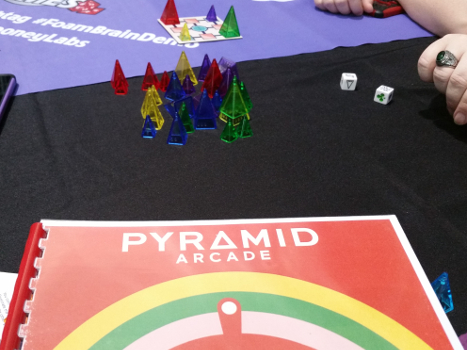 The Looney Labs crew was on hand to show off their Pyramid Arcade, a box set compilation of the company’s iconic abstract pyramid games. They had a couple proof sets on hand that looked excellent, and I even got to play a few of them over the course of the event. If you like simple abstract games, consider checking this set out while it’s on Kickstarter.
The Looney Labs crew was on hand to show off their Pyramid Arcade, a box set compilation of the company’s iconic abstract pyramid games. They had a couple proof sets on hand that looked excellent, and I even got to play a few of them over the course of the event. If you like simple abstract games, consider checking this set out while it’s on Kickstarter.- Breaking Games nee AdMagic was showing off a whole swath of games, though it seemed the two most popular on display were easily 2015’s Boomtown Bandits, which they’re promoting in earnest now after the game’s initial soft release, as well as the dexterity game Klask. It’s basically miniature air hockey using magnets, but it was constantly being played, even garnering attention from a local news segment.
- Game Salute was on hand to showcase their current stuff, including (mostly) recent releases Skyway Robbery, Legends of the American Frontier, and Dungeon Scroll. There was no brand new debut on hand, however, as a couple of their campaigns were beset with delays due to plastics issues. I’m not at liberty to discuss the details of such at the moment, but much as many people like to deride Game Salute for, well, everything, I can attest that at least in this particular case it’s not their fault and is completely out of their hands.
- Greenbrier Games was demoing off a bunch of current and upcoming titles, including the newly-released two-player tactical game High Heavens (finally) and the upcoming Project A.E.G.I.S., a (usually) quick skirmish game of robots clashing to destroy each other. I also got to playtest Escape From The Sanitorium, where players are trying to escape an insane asylum using Puerto Rico-style Lead/Follow card mechanics. The catch is that, due to bouts of insanity, it’s usually your opponents picking which action you take each turn, and vice versa.
- The local Aviary Games team behind last year’s aptly-named Alchemy were demoing their slightly-meatier next game Crown of Exile whose campaign finished just after the convention concluded. I still prefer its previous name, Interregnum, but I do like the streamlining they’ve done since demoing it a year or so ago. So I’ll be curious to see what the final product looks like.
-
Greater Than Games was on hand pushing Bottom of the 9th pretty extensively (conveniently in time for the expansion). They also interspersed some demos of New Bedford, but…I just couldn’t. It looked nice though?
- Tim Fowers (of Paperback and Burgle Bros fame) was showing off his next game Fugitive in the Kickstarter room much of the time, which of course meant we had to check it out. Fugitive is a small two-player cerebral game using just 42 cards. Taking place after Burgle Bros, one person is the escaping fugitive trying to place ever-increasing card values face down in a row to escape. The other person is the law trying to guess what the face down card numbers are. It sounds simple admittedly, but it’s surprisingly thinky for such a short game. It should be heading to Kickstarter next month if all goes well.
That Being Said…
For all of the positive things at PAX this year that seemingly made the trip a moderate to above average success, PAX continues to be plagued with problems that they seem keen almost on not fixing. We enjoyed our attendance overall, even if we aren’t the main demographic the convention is catering to. Yet because of these perpetual issues, each year it gets slightly harder and harder to justify making PAX worth it – at least from a tabletop perspective. While there are plenty of publishers, and industry professionals who inquire about attending from other parts with regards to the tabletop segment of the expo, I once again have a hard time encouraging people from outside the area to go through the hassle of attending if they haven’t done so before.
I don’t want to harp on PAX East’s shortfalls in every annual recap. There are areas that they have made genuine progress on over the last few years that are worth championing, such as their creation of a safe space room and a desire to be more inclusive. PAX has often been its own worst enemy at times when it comes to issues of harassment, sexism, and feeling like the bastion of straight white male gamers, but I do feel that they are – slowly – moving past that to a more diverse experience. That includes this year by having a handful of gender neutral bathrooms which elicited zero actual issues (sorry North Carolina).
Sadly, that such reticence isn’t going to change until they address the convention’s handful of systemic problems. I won’t go into extensive detail on these issues, as I tend to spell out several of them every single year. Nevertheless:
The tickets, man, the tickets. PAX East will always sell out at its current size. That’s a guarantee. The amount of people who want to go far outnumber the number of tickets available. So be it. However, when there’s no longer any semblance of fairness in the distribution of those tickets, you have a problem. When I first started going to PAX East in 2012, I knew close to 20 local people who made the trip at least for one day. In 2016, I knew about 6. It hasn’t been for lack of. Rather, it’s because unless you are at a computer desk the moment the unannounced tickets go on sale, you’re pretty much screwed. That is, unless you go through third party sources. Also known as scalping. Which is ridiculous.
For 2015, 3-day passes sold out in 12 minutes. This year it rose to a whopping 20 minutes. Saturday passes sell out in hours. And so on. The larger issue is the perception that PAX doesn’t care since the tickets will sell no matter what. The price keeps going up, but the availability to the average person keeps dropping, which is unsustainable. Boston is already an expensive enough city without worrying about finding scalped tickets to a game convention. Think of how dumb that is. Just make the damn tickets non-transferrable. Even when you sell out, at least it shows that the tickets are going to people and not bots or scalpers. Perception is key here.
 Always with the lines, lines, lines!
Always with the lines, lines, lines!
PAX has over 70,000 individuals wandering around its halls, so lines are inevitable. I actually thought that the lines were slightly better this year overall unless you were on the expo floor itself. They seemed to have a better grasp on line management, but lines were still everywhere. “Hurry up and wait” should be the convention’s mantra, really.
Encouraging use of the food trucks and local off-site food establishments helped alleviate some of the food lines, as did moving the snack kiosks out of the tabletop area. The aforementioned tabletop games library also was a big improvement. Ultimately, though, the convention as it exists can only hold so many people at one time, whether it’s for food, games, or the bathroom. Only the BCEC expansion will be able to address this in any lasting capacity, but that plan was put on hold by the Massachusetts governor for the time being with no timetable for starting it up again. Yay politics.
Metal Detectors? Yeah, these were new to the BCEC this year…and they were completely unnecessary. I felt like I was going into the airport every time I wanted to go get a sandwich. One police officer I spoke with claimed it was heightened security because of Paris and Brussels, so I’m hoping this isn’t a permanent fixture. All it did was make it harder to get into the building, funneling everyone through the front doors, which was frustrating at any point while the sun was up. They didn’t make anyone I talked to feel safer and just came across as a waste of time.
Speaking of the BCEC Expansion. One of the great things about conventions like Gen Con is that they make use of their surroundings, including all of their adjacent downtown hotels. PAX really needs to do this, at least with the hotel next door. It has several areas that go unused that could be great for adding in more panels and / or offsite gaming events. If we aren’t getting more hotels in the area due to the expansion pause, then they really need to take advantage of extra space. This has started in an unofficial capacity, but it’s a missed opportunity if there ever was one if they don’t start using the hotel halls too for scheduled events.
Expand Tabletop. Alright, so I’m a little biased on this one. While 2016 did a much better job wrangling in/back many of the big video game companies absent from last year, the tabletop area’s growth was anemic. I get why; I just don’t like it. In many ways, the current tabletop setup is a means to placate the board gaming crowd and give people something do do after 6PM when the expo floor closes. PAX doesn’t make a ton of money from the Tabletop booths, so there’s not a huge incentive for them to rearrange the tabletop floor plan to allow for more of them. Some publishers wanted to attend this year and couldn’t due to lack of space, while others were forced to choose between a more expensive expo booth or nothing at all.
I think they can do better. You’d be able to add another dozen publishers easily without mucking up the current layout much. Sadly, the current mindset seems to be that between the comparatively low cost of renting tabletop booth space and the amount of additional exhibitor badges they’d have to hand out, it isn’t worth the effort since expanding isn’t going to generate more people through the door. I on the other hand think it’s a missed opportunity if there ever was one.
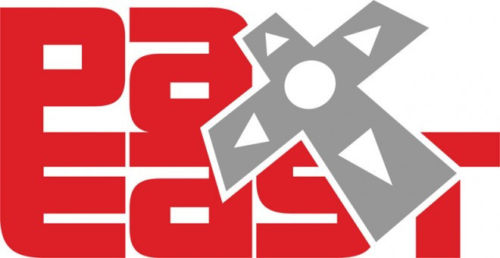
Attending PAX is like a geek marathon. It’s long and tiring, it requires patience and endurance, and you need a shower afterwards. Traditionally, the payoff has been generally more positive than negative, and compared to 2015 PAX was a definite improvement. It still has a ways to go, however, as PAX has become self-limiting in how difficult it is to participate. Until that’s corrected, PAX will grow increasingly unsustainable. Or worse, people will give up trying to attend, and retention will drop. This year felt better organized and slightly less crowded, but the tabletop side is in danger of stagnating if new faces and a larger footprint aren’t something that’s considered. At the end of the day, it was worth the lines, traffic, and costs. We’ll see what 2017 brings.
I hope you got to read about some interesting things here. Goodbye until next spring PAX, when we forget about all your flaws and will be lining up to do it all over again.
Photo Credits: Pax Logos by PAX Site; Potholes by Janelle; Lazer Ryderz by Cardboard Fortress; Indie Megabooth map by Indie Megabooth; Brass Empire by Rock Manor Games; Depths of Durangrar by Creative Cove Games; Moonquake Escape by Breaking Games; Lanterns cover by Foxtrot Games; South Park by Comedy Central.

